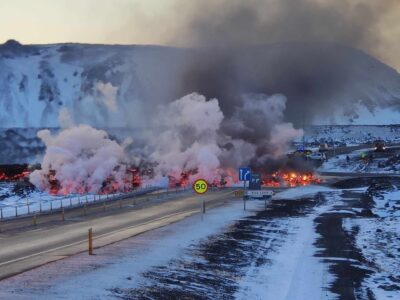GEA overview on international geothermal development in 2014
The U.S. Geothermal Energy Association (GEA) provides an overview on international geothermal development and its events to be held in 2015.
Geothermal power in 2014 witnessed continued global growth, steady expansion in the number of countries with developing projects, and a solid increase in on-line capacity of between 4-5% for the third year in a row. The world market reached upwards of 12.7 GW (gigawatts) of geothermal power operational throughout 24 countries, reflecting about 700 MW (megawatts) of combined added growth. By comparison, the global industry added about 600 MW in 2013. As of the end of 2014, there are also 11.7 GW of capacity additions in development and 1.8 GW of power under construction in 80 countries. These trends show that geothermal’s place in the global energy market is secure and steady.
To support this growth, the World Bank and other multi-lateral organizations focused on early risk mitigation. Meanwhile, national-level governments around the world sought to line up policies that will most successfully increase domestic electricity generation without adding to the threat of global warming. The result was expanded geothermal production and development, and based on the additional projects already in process, it looks like the trajectory will continue for at least another decade. The global geo power industry is on track to reach 20 GW of on-line capacity, if not more, by 2024.
International Market Developments
More and more U.S. companies take their experience and technology overseas, catapulting the international market toward sustained and unprecedented growth and inspiring other nations to create favorable conditions for trade.
This year emerging economies in East Africa, Central America, and the South Pacific experienced the fastest growth, and each of these regions had some notable developments:
In the East Africa region, a new 280-MW addition at the Olkaria field in Kenya now has the world’s largest flash plant, and Kenya added 300 MW of capacity overall. In Ethiopia, a partnership between the government and the World Bank expects to expand electricity access where it is most needed by adding four million more people to the grid in the next five years. Geothermal would be the second largest source of power supply in East Africa by 2040.
In Central America, Costa Rica received a $550 million loan from the Japan International Cooperation Agency toward planned capacity of three geothermal plants each totaling 55 MW. El Salvador reached the milestone of producing 25% of its electricity from geothermal energy with an aim to achieve 40% in the near future.
And in the South Pacific, Indonesia is leading in developing capacity and could surpass the U.S in installed capacity in the future. Financed by the Japan International Cooperation Agency with equipment from Ormat, construction began in Indonesia on what will be the largest geothermal plant ever built, the 330MW Sarulla project. In the Philippines, the Energy department announced plans to increase installed capacity of geothermal power to 3.3 GW by 2030.
Internationally, the value of geothermal is recognized and supported by several new laws and policies:
Mexico passed a particularly significant law that opened its energy market to private and foreign participation; it aims to stimulate renewable energy development and has specific guidelines for geothermal exploration and development.
Indonesia, which holds up to 40% of the world’s largest reserves of geothermal energy potential, passed a law that separates geothermal from mining laws thus opening new areas for exploration. In response to company cost issues, the law also stipulates higher prices for electricity produced by geothermal.
U.S. Market in Planning Mode
No new power plants were put online in the U.S. this year, in part due to the lapsing of federal production tax credit for new projects, as well as lowered demand across the market. Meanwhile, state policies recognize the value of solar power and natural gas but do little to recognize geothermal power’s attributes.
Despite a lack of new added capacity in U.S. states, future development was a hot topic in western states:
In California, the legislature succeeded in passing AB 2363, which directs the state’s Public Utilities Commission to improve its renewable power valuation process and this could help geothermal’s future prospects in the state. The state legislature came critically close to passing legislation supporting the Salton Sea Restoration and Renewable Energy Initiative that would promote geothermal energy to help address looming regional environmental problems. The legislature is expected to take up legislation supporting the Initiative once again in the new year.
Oregon spearheaded new initiatives that recognize the value of geothermal power. The industry is optimistic that state policies like Oregon’s will spread to other western states and could spark another period of growth in the U.S. over the next decade.
Nevada is one of the largest producers of geothermal today and continued to announce new projects underway, and New Mexico introduced its first geothermal power plant (although this wasn’t counted as new power in 2014 because it was counted in 2013).Alaska, Hawaii, Idaho, Washington State, and others are all making various contributions to their geothermal plans.
Geothermal Technology Evolving
Skilled geothermal companies continued to make important technological advancements. Some notable headlines of progress were made in mineral recovery, hybrid power systems, and Enhanced Geothermal System (EGS) demonstrations over the past year:
Simbol Materials’ mineral recovery project in southern California could become the first plant to produce lithium and other minerals from geothermal power plant brine. The expected output is 15,000 metric tons of lithium annually, and while Simbol will initially produce lithium carbonate and lithium hydroxide for battery manufacture the projects is seen as a possible breakthrough on the path to producing a list of other strategic minerals in the future.
Enel Green Power put online the first solar thermal hybrid plant and began construction on the first biomass thermal hybrid plant.
The U.S. Department of Energy (DOE) continued supporting ongoing research and introduced its FORGE program (Frontier Observatory for Research in Geothermal Energy) to establish a subsurface laboratory. FORGE is envisioned as a center for the R&D community to share data and gain understanding for future successes.
Outlook for 2015
Both the U.S. and global market are expected to see continued growth in 2015. The U.S. market may grow slowly while state and federal policies are adjusted, but with continued pressure to address climate change and a growing recognition of the important values of geothermal power to grid reliability, that is expected to improve. The global market should see strong growth with a continued expansion of countries producing and developing geothermal power. Meanwhile, U.S. companies expect to continue to make progress to meet the needs of the marketplace for clean, reliable renewable power with improved performance, flexibility and availability.
Events in 2015
Over the course of 2014, GEA held a series of annual events that brought together industry and policy leaders from around the world. These events are not only educational in nature, but they serve as the front line for doing business. The events included the GEA International Geothermal Energy Showcase in Washington, D.C., the National Geothermal Summit in Reno, and the GEA Geothermal Energy Expo in Portland. Attendance at these events was at a high in 2014, and more countries were represented than ever before.
GEA Events in 2015 will include:
· February 24, 2015, State of the Geothermal Industry Briefing, Washington, DC
· June 3-4, 2015, National Geothermal Summit, Reno, NV
· September 20-23, 2015, GEA Geothermal Energy Expo and GRC Annual Meeting, Reno, NV


















